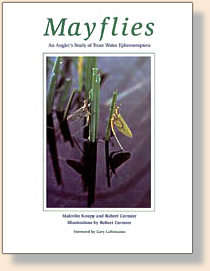This is a big one. Mayflies, all 366 pages
of it, it chock full of information. It truly is a marvelous work.
Do not take this book lightly, it is serious stuff. The insects in
all stages are here. The patterns or recipes are here. Drawings
are very detailed and accompanied with explainations, but color
photographs are very limited. There are hatch charts. Data on
when the various mayflies emerge, and tables showing peak
times in specific regions. And - how to fish the various flies.
We received a copy delivered
this week - an unexpected surprise! I knew the
book was in process; promo information was at
the Amato booth at the Salt Lake fly tackle dealer
show. I did not ask for a copy of it, because
frankly it is expensive, and I have a problem asking
a company to "comp" anything. That said, I was
doubly delighted when it arrived. As publisher of
this website, I needed a really good reference on
fly tying. Even though I taught tying years
ago, I am not an expert! And I need to be able
to answer questions, find sources for folks with
problems and keep up with what is new in
tying in general. Thanks to the folks at Amato
I can now do that.
I wanted to check just how
good the book is. So, since the
Fly of the Week this
week is Hexagenia lambata, I looked up the insect.
Of course it's there - and so is the nymph. Does
anyone think of fishing the nymph? The authors have
given rather extensive thought to fishing this nymph.

"To initiate the emergence process,
the nymphs abandon their burrows, and after moving about
on the river-or lake bed swim to the surface film with a
wiggling action. Many nymphs may pause about midwater,
either to await further signals that metamorphosis is imminent
or to regain their strength before continuing their ascent to the
surface. Due to the enormous size the duns frequently encounter
difficulties in casting off the nymphal casing and may struggle
in the surface film for several minutes before completing their
transformation."
The authors then proceed to give the
recipe for dressing the Traditional or Wiggle Nymph, with
the description of the Natural insect alongside the Dressing.
What a neat method - it both gives you the insect, and teaches
how to do the imitation at the same time.
Following that section is, Fishing the
Hexagenia limbata Nymph, which reads: "Productive
nymph fishing is generally restricted to the hours about dusk
and into darkness, when the nymphs are either active on the
lake or river bottom or are swimming to the surface to prepare
for the duns' emergence. A traditionally tied nymph fished
deep on a sinking line with a strip retrieve, or even bounced
along the river - or lake bed, is a proven technique for imitating
the nymphs before the hatch. At the beginning of the hatch, fly
fishers should change tactics and fish a slightly weighted wiggle
nymph around the silt beds of both lakes and rivers, allowing
the nymph to sink before raising it to the surface with short
strips of line to mimic the undulating motions of the ascending
nymphs. Another successful tactic when fishing a stream or
river is to fish a weighted (to suit the conditions) wiggle nymph
down and across to the vicinity of mud banks and silt beds with
a constant rod action to impart the natural's swimming action to
the imitation. East-Midwest fly fishers have also found success
in fishing Hex nymph imitations during the dull daylight hours
of the fall and early winter seasons on both rivers and still waters."
If that isn't enough, the next section is
on Emergers, followed with the Dun and finally the Spinner.
Each with the imitation, and how to fish it.
Just picture your favorite water, the
mayflies you have - and how much information is in this
book! On your mayflies! If you are serious about your fly
fishing and have mayflies you should have this book. It will
improve your success rate. ~ DB

Previous Reviews
|

